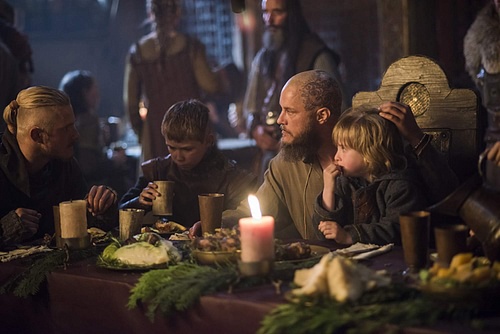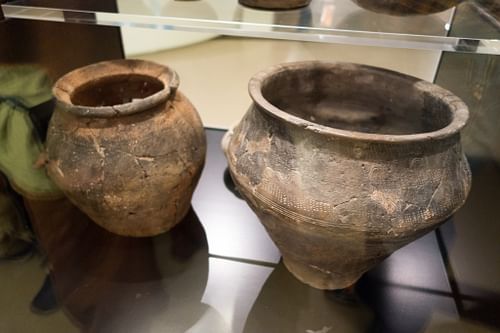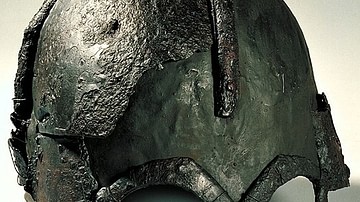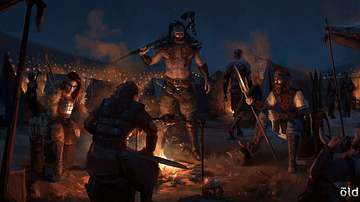In many depictions of Vikings, whether in film or other media, a group is often seen gathered around a flaming pit while an animal of some type – usually a boar – turns on a spit above. While the people of Scandinavia certainly ate meat, it was not a central part of their diet as they seem to have relied more on dairy products, fruits, and vegetables. The Norse diet, including those known as Vikings, was far more diverse than how it is represented in modern-day media and included a wide range of food types.
The most common foods were:
- Dairy products (milk, cheese, curds, whey)
- Grains (wheat, rye, barley, oats)
- Fruits (strawberries, raspberries, blackberries, crabapples, apples)
- Nuts (hazelnuts and imported walnuts)
- Vegetables (peas, beans, onions, cabbage, leeks, turnips)
- Fish (as well as eels, squid, seals, and whales)
- Meat (cows, sheep, goats, pigs, horses, chickens, ducks, seabirds)
Salt was expensive to make as the usual method would be to boil down salt water, which required a significant amount of timber for the fire as well as the time it took to complete the process. Salt was more often imported, making it a luxury not everyone could afford. Meat, therefore, had to be consumed shortly after the animal was killed because, for most people, there was no means of preserving it. The foods most commonly stored were dairy products sealed in barrels or ceramic jars (especially skyr, a kind of yogurt), dried fruit and vegetables, and grains.

The most common drink was ale – for men, women, and children – and an alcoholic dairy-based beverage known as syra, a by-product of making skyr. Mead (a honey-based drink) and wine from grapes (imported from places like Germania or Francia) were both expensive and out of reach of most people. Scandinavian wines were fruit-based (apple wine, strawberry wine) and, like ale, syra, and mead, were initially made by women.
The Norse of Scandinavia and the Viking raiders who traveled on raids overseas required a significant amount of energy on a daily basis, and this diet seems to have more than sufficed. Scholar Martin J. Dougherty writes:
There is little evidence to suggest that the Vikings were underfed or suffered from nutritional deficiencies, so an adequate supply of food must have been available year-round, at least most of the time. (83-84)
When the Norse went on raids to other countries, they carried enough provisions for the trip and for at least a few meals once they reached their destination; afterwards they would have lived off the land. At home, however, a plentiful supply of food was provided by each person's farm and the surrounding environment.
Dairy Products & Grains
Agricultural technology in Scandinavia was fairly primitive during the Viking Age (c. 790-1100 CE). The metal plow was unknown in Scandinavia and fields were cultivated using an ard-plow (also known as an ard, a light plow with a wooden spiked share which cut the soil) pulled by an ox and steered by the farmer. The scythe was also unknown and fields were harvested using small hand-scythes.
It was not just the lack of technological innovations which made farming so difficult, however, but the short growing season, lack of steady sunlight, and the nature of the environment. Scholar Jesus Fernando Guerro Rodriguez notes how, “in Norway, geographical factors, such as considerable differences in elevation and the limited amount of arable land, made it difficult to survive solely on crop growing” (18). The people, therefore, relied more on hunting, fishing, and animal husbandry.
Cows were kept for their milk; and the cheese, curds, and whey that could be made from that milk. The most common Scandinavian dish included or was solely skyr, a kind of yogurt which is still produced and consumed, especially in Iceland, in the present day. Skyr would be flavored with berries, apples, or other fruits as well as with grains which were also easily preserved.
Skyr may have been popular but does not seem to have been one's preferred meal if there were other options and was thought a paltry offering to a guest. Rodriguez notes a number of Icelandic sagas in which skyr features as a telling detail in the character of a host. In the Bjarnar Saga, for example, Bjorn is traveling through Iceland and stops to ask for shelter for the night from a farmer. He is served dinner and, while eating, asks the farmer, “How do men call such provisions in your district?” When the farmer says it is called skyr and cheese, Bjorn responds, “In ours, we call such provisions `enemies' joy'” (Guerro-Rodriguez, 22). Still, skyr was a staple of the Scandinavian – especially Icelandic – diet.

Grains were made into ale, mead, and bread, and there is plentiful evidence of fermented grains kept in ceramic pots. Fermentation of grains produced a sour-tasting bread and resulted in the popular sour bread still enjoyed today. Scandinavians also ate the eggs of chickens and ducks as well as the fowls themselves, often in a stew slow-cooked over a fire, with assorted vegetables and herbs.
Fruits & Vegetables
Evidence of the consumption of fruits and vegetables comes primarily from archaeological excavation, in which seeds or even preserved fruits have been found. Further, excavations at a number of sites have been able to determine the difference between cultivated fields and kitchen gardens which would have been used by the woman of the house in preparing meals.
There is also evidence in the form of an abundance of walnut shells at certain sites (such as Hedeby) strongly suggesting they were a popular snack even though they would have had to be imported. Likewise, peaches – also an import – were popular as a flavoring, in wine-making, and as a dried snack.

The kitchen garden seems to have focused on both vegetables and herbs. Kale and gale were the most common vegetables in these gardens but also sage and possibly the opium poppy, both most likely used for medicinal or ritualistic purposes (sage was thought, and still is, a potent herb in cleansing a home of bad spirits). Cultivated fields produced turnips and a variety of legumes as well as onions, cabbage, and celery.
Fish & Sea Life
Aside from the vegetarian diet, Scandinavians took full advantage of the rivers, streams, and the sea. Fish from fresh and salt water as well as eels, squid, seals, walruses, and whales were eaten frequently. Seafood could be preserved through drying or fermenting in brine and remained fresh as a staple food. Whales are mentioned a number of times in the Icelandic Sagas and almost always as having been washed up on the shore and killed and harvested there rather than hunted.
Scholar Kirsten Wolf writes, “both whale and seal meat were considered delicacies and the oil was used for lamps and, in the case of seal oil, as an alternative to butter” (107). As with other creatures hunted for food, every part of the whale was used for some necessary aspect of life but to actually go and hunt a whale was considered too dangerous. Scholar Alan Baker makes note of this in relaying a story of a Norse fisherman discussing his daily routine as told in the Colloquy of Aelfric, Abbot of Eynsham (c. 955 - c. 1010 CE):
He begins by boarding his boat and casting his net into the river, followed by a hook, bait, and basket. He sells his fish to the people of nearby towns who eagerly buy his eels, pike, minnows, turbot, trout, and lampreys. Sometimes he fishes in the sea, but not often, as it takes a lot of rowing to get there. When he does fish in the sea, he catches herring, salmon, porpoises, sturgeon, crabs, flounder, and lobster, among many other things. When asked why he does not catch whales, the fisherman replies that it is very risky to go after whales and it is far preferable to catch a small fish that can easily be killed than to chase a large animal that can kill one with a single stroke. (138)
Fish and other sea creatures were also used in stews, one of the most popular dishes because it could be left over a fire to keep for days, but were also preserved through salting, drying, smoking, or fermenting in brine. The Norse also harvested dulse, a red alga, from the seashore which was an important source of vitamins and frequently included as part of one's daily diet.
Fishing was such an integral aspect of Norse life that it frequently features in the Icelandic Sagas as a plot device. The mention of livestock in the sagas is also noteworthy but cattle were kept primarily for milk production and working the land (in the case of oxen), not as a major food source.
Meats
All evidence suggests that cows were only slaughtered after they had stopped giving milk, and the same is true of sheep with their wool and goats. Most meat dishes came from wild game that was hunted such as rabbits, wild boar, elk, deer, seabirds, bear, reindeer, and squirrels. Pigs were kept as a meat source, and horse meat was also eaten only rarely as horses were highly prized and very expensive. Dogs and cats were kept as pets and companions and were never a food source.
The Norse valued the cat and dog so highly that one of the most popular goddesses, Freyja, rides in a chariot drawn by cats and dogs were thought to accompany their masters into the afterlife (more dog skeletons have been found in Norse graves than in those of any other culture). Seabirds were frequently caught and eaten, but some birds were strictly off limits as game, most notably the hawk and falcon, which were prized by royalty and could command high prices.

Meat was prepared in a number of ways but was most often boiled (as were other dishes). Boiling food was the most common means of preparation because one could complete other tasks while the food was cooking and the meal could feed a large number of people. The meat would be cut up and put into a cauldron over fire, to which, presumably, would be added various spices and vegetables. The result could be a stew or simply boiled meat with vegetables, served with a chunk of bread. Meat might also be cooked over an open fire on a spit – as in the famous depictions of Viking meals – or slow-roasted in soapstone pots placed on hot stones in a pit.
Meals & Feasts
Family meals were eaten in a common room of the house. This meal was often either a stew served with bread or, in Iceland at least, skyr and cheese with bread. The Norse ate two meals a day: one, the dagveror (day meal) shortly after waking in the morning and the other, the nattveror (night meal), in the evening, roughly around 9:00 pm (21:00). These meals were served in wooden bowls and eaten with wooden spoons.
Everyone had a personal knife which was an all-purpose tool and, at the table, served as both knife and fork. The fork was unknown in Scandinavia during the Viking Age but a pointed stick was sometimes used for the same purpose. The family would gather at a table in the central room of the house and sit on benches. Most tables were of rough wood but wealthier families had crafted and polished wooden tables covered by a linen table cloth.
Aside from the daily meals, there were ritual feasts – such as at weddings and funerals or to seal a business contract – and the famous sumbl, the Viking drinking party. The sumbl involved far more drink than food, and, as with the meal in one's home, was prepared and presented by women.
Drink
One could not have a meal without a drink, and one would not have had the drink without women. Author Mark Forsyth notes how, “serving the drinks was the defining role of women in the Viking Age” (123). Women were also the first brewers and wine-makers until, as in other cultures, men became involved and eventually dominated the process.
Ale, mead, and wine were made in roughly the same way. A cauldron or vat would be filled with water and placed over a fire to heat, and one then added honey and yeast (for mead). One would bring the mixture to a boil and then place the open vat beneath some sort of fruit-bearing tree to catch the wild yeast. To make ale, one left out the honey and substituted malted barley and, to make wine, one used fruit instead of barley. Alcohol content was regulated by the amount of sugar added (from tree sap), and honey was supplied by bees which were kept in special hives on the property. Besides tree sap, honey was the only sweetener available in Viking Age Scandinavia.
Once the ale or mead was brewed, it was left to settle and then strained into ceramic jugs and stored. Neither ale nor mead was carbonized because the vat, and later the jugs, were not air-tight. The brew would be left alone while the brewer returned to the cauldron or vat to process the dregs for making barneol, ale for children. Everyone, of every age, drank alcohol for health reasons since alcohol was so much safer to drink than water, and the most popular alcohol was ale.

Even so, mead was considered the drink of choice if one could afford it. The primary difference between ale and mead was honey, and not everyone could afford their own private hive of bees or the time and effort it would take to locate a hive in the wild. Wine made from grapes was the most expensive alcoholic beverage because it had to be imported. Wine was so rare and expensive that it was said to be the only drink of Odin, chieftain of the gods and also the Norse god of alcohol.
Besides these drinks, there was syra, which was a sour brew by-product of making skyr, and the buttermilk known as misa. Syra was made from skimmed milk and rennet (curdled milk from the stomach of a newborn calf) and left to ferment for at least two years before it could be served. Like skyr, syra was a popular and cheap drink but it was not considered honorable to offer it to guests. The Norse placed a high value on hospitality, and one was expected to offer guests only their best in food and drink. Offering a guest syra – especially if one had ale or mead in the house – was a serious social offense.
Conclusion
There was, clearly, far more to the Norse and Viking diet than just the roast boar turning on the spit. Although the Vikings are routinely depicted as savage, disheveled warriors whose diet and personal hygiene were the least of their concerns, they actually took an acute interest in both. Excavations of ancient fortifications, homesteads, and communities – which include sifting through ancient garbage pits and toilet facilities – show that the Norse diet was quite varied and no doubt healthier than that of most people living in the modern day.
All of the food consumed by the Norse of Scandinavia was made and served fresh. The lack of means for preservation meant that animals slaughtered were consumed quickly and, even when meat or fish was preserved, it was probably eaten a short time later. The foods most often preserved for long periods, such as through the hard months of winter, were grains and dairy products (like skyr) or bread.
There was no need for any particularly restrictive diet because the Norse were quite active, and food was eaten probably in great quantities at a sitting to maintain the energy for such a lifestyle. As with all other aspects of life to the Norse, food was a gift from the gods and was meant to be enjoyed either by one's self or, even better, in the company of friends and family. Even the most meager meal was prepared with the possibility of uninvited guests appearing at one's door who would require hospitality and was celebrated through the companionship of those around the table.





